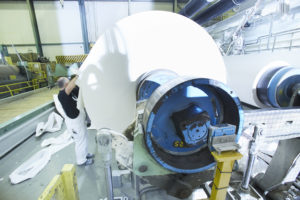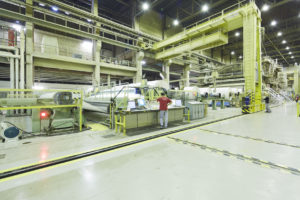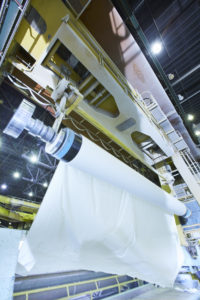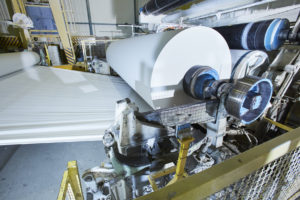It is clearly evident that digitalization has left its mark on the paper industry. Does the “print media” face an uncertain future or will haptic page turning hold its own? – both theories have their proponents. The digital age has long been a reality in paper production. The company Kabel Premium Pulp & Paper and its paper mill are impressive proof of this. Showing no sign of dark clouds on the “print horizon”, workers manufacture roll upon roll of high-quality paper around the clock.
To maintain an overview of the multi-step production process, Kabel Premium Pulp & Paper utilizes an RFID-based identification solution, integrated in a high-performance, wireless transmission system with an interface as part of its own in-house IT system. This enables workers at Kabel to use RFID technology to constantly track which production step is currently being processed by a given paper batch.
Since 1896, Kabel Premium Pulp & Paper has been manufacturing by the running meter for the biggest printing houses in Europe. The Hagen-based company in Germany's Westphalia region initially manufactured newspaper; now it specializes in coated paper for high-quality catalogs and magazines.
Two giant paper machines and 540 workers operating in a three-shift rotation handle a total capacity of around 485,000 tons a year. Wound onto rolls weighing many tons, tens of thousands of meters of paper are made according to client specifications before being delivered to customers in the requested widths.
Paper Heavyweight
Anyone who sets foot on the factory floor in Hagen is sure to find themselves in an impressive world that sees heavy rolls of paper suspended throughout the long hall. Overhead cranes transport them from one processing step to the next. Depending on the particular paper thickness, the rolls measuring 7.20 meters wide carry around 50,000 to 60,000 meters of product and weigh up to 20 tons.
Kabel Premium Pulp & Paper produces each and every roll of paper – a “tambour” in technical jargon – in line with client specifications. The multi-stage paper production process begins with the manufacturing of the base paper. As it is still very rough, it is not suitable for high-quality print products. That is why the paper is smoothed in a second step, i.e., coated on both sides with special chemical materials. Depending on the desired paper quality and surface finish, the tambour then runs through the calendering machine, which smooths the surface under pressure. The calendering machine removes unevenness in the paper so that the contours do not become blurred during subsequent printing. Before leaving the factory, the rolls are cut to the desired individual width on the slitter rewinder to make processing easier for customers.
The paper is wound onto metal cores so that the rolls weighing several tons can be transported. These “tambour cores” made of robust metal are hung at their ends at each stage of production and are also transported as such by the overhead cranes. Around a hundred of these tambour cores are in continual use in Hagen.
Every Roll in Sight
In circumstances such as these, production faults in Hagen can mean tens of thousands of meters wasted. To reliably keep a close eye on the production of each individual roll, Kabel Premium Pulp & Paper uses a custom-made RFID solution from system integrator Intelligent Data Service (IDS) with RFID technology and 26 RFID reading devices provided by the sensor experts at SICK. “We required a solution to ensure the automatic detection of tambour cores in the production flow,” explains Johannes Broer, who is responsible for IT at Kabel Premium Pulp & Paper. “Our requirements included, among other things, reliable system components and wireless data transmission to our IT system. The components used are exposed to process-related contamination, dust, and heat. They must be able to withstand contact with chemicals or machine oil. We had to rule out optical detection-based solutions due to the risk of contamination. This was also the case for visual markings, which do not stand up to contact with oil, for example.”
In addition, a solution with very short read times was required, since the tambours are constantly in motion. “We mark our tambours with an eight-digit number, which comprises both the date of production as well as the year. The tambour cores feature a three-digit number. Apart from the fact that the reading stations can be hard for our workers to reach, the long numbers can also result in manual input errors. Automated detection allows us to ensure accurate tracking and relieves some of the burdens on our workers,” adds Broer.
This is why the tambour cores are marked with passive RFID tags, which are read at individual stations. When the tambour is rolled out for the first time, the system records which tambour core the batch is assigned to, and from this point on, each station will accurately read out via RFID technology which tambour core the paper is being wound onto and from.
A total of 26 UHF-RFID reading devices from SICK are being used at the factory in Hagen in order to decipher the passive tags on the cores. Depending on the reading distance, RFU620 are used for a scanning range of up to one meter and RFU630 for larger scanning ranges. Passive RFID tags have no energy source of their own that would require regular inspection and are more reliable than active tags when it comes to processing. They are the ideal option for objects that come under heavy mechanical strain such as tambour cores.
Digital System Supplied on Site
To optimally align systems to the individual application, the application specialists from SICK always carefully inspect the situation on-site at the factory. It goes without saying that they did this in Hagen too. This is because a number of aspects had to be observed in this case: Metal reflects radio waves and can result in system faults. It is for this reason that the RFID tags on the metal cores had to be strong to a point that close proximity to metal wouldn't pose a danger.
IDS integrated the SICK reading devices into its roll online tracking system, known as “Rolf”, which it had developed itself. The system collects all results directly from the RFID reading devices, visualizes them, and makes the data available for further processing. This means that all process data can easily be viewed in the productive database at Kabel Premium Pulp & Paper and each tambour directly assigned. “It was a tall order and we are happy to have found the right partner in SICK,” explains Rainer Marchewka, Managing Director of IDS. “We have been working with SICK for 15 years. We know that we can rely on them and also that long-term system support is guaranteed.”
In order to keep installation outlay at the factory low, IDS first built the entire system, including all RFID reading devices, true to scale at its own premises, where it tested and optimized the system processes, and then finally delivered the pre-configured system to Kabel Premium Pulp and Paper for installation.
 RFID technology based roll tracking has now been in operation for over a year. “We are happy that we opted for this solution. In truth, we have worked with RFID-based identification solutions previously, albeit with active tags. These are indeed advantageous when it comes to reading range, but the battery runtimes were too short and also the tags were too susceptible in this environment. We are very pleased with this solution and the collaboration with IDS and SICK,” says Johannes Broer.
RFID technology based roll tracking has now been in operation for over a year. “We are happy that we opted for this solution. In truth, we have worked with RFID-based identification solutions previously, albeit with active tags. These are indeed advantageous when it comes to reading range, but the battery runtimes were too short and also the tags were too susceptible in this environment. We are very pleased with this solution and the collaboration with IDS and SICK,” says Johannes Broer.
Quite in keeping with the development of “Industry 4.0”, Kabel Premium Pulp & Paper is laying foundations for the “intelligent” factory of the future with the RFID technology “Rolf” system in Hagen. The company is testament to how proven production machines and state-of-the-art networking technology can be brought together harmoniously and efficiently with the right system solution.









